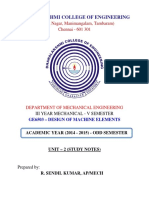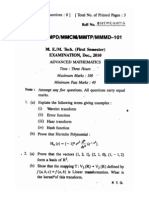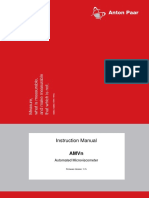Mechanics of Material Lab Report Angle of Twist
Mechanics of Material Lab Report Angle of Twist
Uploaded by
Ahsan MumtazCopyright:
Available Formats
Mechanics of Material Lab Report Angle of Twist
Mechanics of Material Lab Report Angle of Twist
Uploaded by
Ahsan MumtazOriginal Description:
Original Title
Copyright
Available Formats
Share this document
Did you find this document useful?
Is this content inappropriate?
Copyright:
Available Formats
Mechanics of Material Lab Report Angle of Twist
Mechanics of Material Lab Report Angle of Twist
Uploaded by
Ahsan MumtazCopyright:
Available Formats
To investigate the relationship between angle of twist of the rod and ,Torque applied,
Length of rod and Diameter of the shaft
by
Afaq-ul-Hassan 12-ME-012
Adnan Ahmed Malik 12-ME-010
Ahsan Mumaz 12-ME-015
Asadullah Turi 12-ME-020
Section-C, Group-1, SubGroup-1
10:30AM-12:30PM, 03 January, 2014
Date of Laboratory Report: 3 January, 2014
Report submitted to: Imran S.S. Ghumman
Executive Summary
In the experiment we used three different types of cylindrical rods of same material and
apply the torsional stresses several times to find out angle of twist by keeping torque , load
and length constant one by one in three cases. There we have different diameters of same
materials. The shear stress acts only in radial direction so therefore the cross section area
remains constant without deforming.
OBJECTIVES
To investigate the relationship between angle of twist of the rod and
a) Torque applied (By keeping diameter and length of the beam constant)
b) Length of rod(By keeping applied diameter & torque on the beam constant)
c) Diameter of the shaft(By keeping applied torque & length constant)
TEST DESCRIPTION
This experiment is consist of three cases to find angle of twist of rods of same material but
different diameters having different load values (Torque) and of different lengths calculated
experimentally.
We have to find angle of twist using the relation , where is in radians. By the help of
vernier caliper we had find the diameter and the moment arm from centre of the shaft and
the length of rod using meter rule.
Torsion of Rods and Bars Apparatus
Weight hangers
Torsional Stresses on cylinderical Rod
Theory
Diagram of shear stress, , as a function of the radius, , of a cross sectional area. (Adapted from
Mechanics of Materials, Wiley, 2011)
= T / J
(Equation 1)
To calculate the polar moment of inertia, J, for a solid circular shaft, employ the following equation where D
is the diameter of the cylindrical member.
J = (/32)D^4
(Equation 2)
If the shear stress induced in the member is below the proportional limit of the material, then Hookes Law
may be applied so as to calculate the materials modulus of rigidity. In other words, if the stress causes only
elastic or non-permanent deformation, the materials torsional stiffness can be determined. To apply Hookes
Law, the shear stress is related to the shear strain by the following expression:
= G
(Equation 3)
Where G is the modulus of rigidity and is the shear strain. Referencing Figure 1, a geometric interpretation
of the shear stain is represented as:
= ( / x)
= (d / dx)
(Equation 4)
Equation 4 implies that the shear strain is proportional to the product of the radius of the member and the
change in the angle of twist with respect to the longitudinal axis. Substituting Equations 1 and 4 into Hookes
Law (Equation 3) yields the separable equation:
T / J= G(d / dx)
T / GJ =d / dx
(Equation 5)
Separating Equation 5 and integrating with respect to the longitudinal axis will yield an expression that
describes the angle of twist, , for a member that is prismatic and experiencing a constant
internal torque.
d = LT/GJ dx
= TL/ GJ
CALULATION AND RESULTS
Part (a);(When length and diameter are constant)
Material used: Mild steel
Length of the rod = 270 mm
Diameter of the rod = 6.5 mm
Table And Graph 1
Sr.
No
Applied load
Torque Arm
Torque
Displacement
Angle of
twist()
(rad)
1 2 0.1 0.2
2 4 0.1 0.4
3 6 0.1 0.6
4 8 0.1 0.8
0
0.1
0.2
0.3
0.4
0.5
0.6
0.7
0.8
0.9
0 1 2 3 4 5 6
Angle of Twist
Torque
Part (b);(When torque and diameter are constant)
Material used: Mild steel
Load applied = 4 N
Torque on rod = 0.391 Nm
Diameter of the rod = 5.43 mm
Table And Graph 2
Sr. No Length of rod
Displacement
Angle of twist()
(rad)
1 0.104
2 0.139
3 0.156
4 0.202
5 0.223
Part (c); (When torque and length are constant)
Material used: Mild steel
Load applied =13 N
Torque on rod = 1.274 Nm
Length of the rod = 270 mm
0
0.5
1
1.5
2
2.5
3
3.5
0 0.05 0.1 0.15 0.2 0.25
Length of Rod
Length of Rod
Table And Graph 3
Sr. No Diameter of the
rod
Displacement
Angle of twist ()
(rad)
1
1.01
2
CONCLUSIONS
It can be seen that angle of twisting is directly proportional to the length and angle of twisting
is proportional to applied force. It is visible that angle of twist is inversely proportional to the
diameter of the rod means more the diameter less will be the observed angle of twist. But a
very small strain no doubt, occurs in the experiment but that is unmeasured able so we
neglected it.
0
1
2
3
4
5
6
7
0 2 4 6 8
Diameter of rod
Angle of Twist
You might also like
- Abu Dhabi University GEN 200 Engineering Economy Fall 2016 Term Project Due: Wed November 23, 2016Document6 pagesAbu Dhabi University GEN 200 Engineering Economy Fall 2016 Term Project Due: Wed November 23, 2016Yong JinNo ratings yet
- All ProblemsDocument107 pagesAll ProblemsjoshiabhijeetNo ratings yet
- Unit 2Document50 pagesUnit 2Ravichandran GNo ratings yet
- Naive Ba YesDocument5 pagesNaive Ba Yeslubna_java2858No ratings yet
- G6 Reading BKLT 2019 PDFDocument5 pagesG6 Reading BKLT 2019 PDFMG JacobNo ratings yet
- Lecture 6 Design of The Crankshaft: ResearchDocument22 pagesLecture 6 Design of The Crankshaft: Researchsujay nayak0% (1)
- Topic 2 Airy Stress FunctionDocument20 pagesTopic 2 Airy Stress FunctionAnonymous ohCM2ktv100% (1)
- ME - 32021 Chapter (I) Machining Processes and Machine Tools - PPTX (Repaired)Document23 pagesME - 32021 Chapter (I) Machining Processes and Machine Tools - PPTX (Repaired)WILYNo ratings yet
- Lecture 4 - Mechanical Advantage, Transmission AngleDocument3 pagesLecture 4 - Mechanical Advantage, Transmission AngleMohankumarNo ratings yet
- MOM OU Old Question PaperDocument2 pagesMOM OU Old Question PaperAmmineni Syam PrasadNo ratings yet
- Plastic Deformation of MetalsDocument42 pagesPlastic Deformation of MetalsNaresh DeshpandeNo ratings yet
- Knuckle Joint Stress AnalysisDocument22 pagesKnuckle Joint Stress AnalysisAshutosh girdharNo ratings yet
- Me6503 Dme Unit 2 Study Notes 2015Document27 pagesMe6503 Dme Unit 2 Study Notes 2015Bala MuruganNo ratings yet
- DrawingDocument8 pagesDrawingTommyVercettiNo ratings yet
- ME8491 Engineering Metallurgy COURSE PLANDocument4 pagesME8491 Engineering Metallurgy COURSE PLANKarthick NNo ratings yet
- Knuckle Joints DesignDocument10 pagesKnuckle Joints DesignKvrd Prasad100% (1)
- Development of Surfaces of SolidsDocument26 pagesDevelopment of Surfaces of SolidsNagaraj MuniyandiNo ratings yet
- A ProjectDocument14 pagesA Projectajay0% (1)
- 2-Lectures LEC 19 Modifications of The Mohr Theory For Brittle MaterialsDocument41 pages2-Lectures LEC 19 Modifications of The Mohr Theory For Brittle MaterialsNagaraj RamachandrappaNo ratings yet
- 20ME403 Engineering Materials and Metallurgy Unit - IV Digital MaterialDocument55 pages20ME403 Engineering Materials and Metallurgy Unit - IV Digital MaterialDark ranger YtNo ratings yet
- Design of PistonDocument22 pagesDesign of Pistonmohil thakor100% (1)
- DME Lesson Plan As Per NBADocument3 pagesDME Lesson Plan As Per NBASabareesan Subramanian0% (1)
- Design and Analysis of PROTECTED FLANGE COUPLING Solidworks 2016 and ANSYS WorkbenchDocument27 pagesDesign and Analysis of PROTECTED FLANGE COUPLING Solidworks 2016 and ANSYS Workbenchamu100% (1)
- Rolling - Nptel PDFDocument10 pagesRolling - Nptel PDFAmit RoyNo ratings yet
- Design of Machine Elements - IDocument69 pagesDesign of Machine Elements - IAnonymous utfuIcnNo ratings yet
- Maximum Distortion Energy Theory or Von Mises CriteriaDocument2 pagesMaximum Distortion Energy Theory or Von Mises CriteriaMonojit KonarNo ratings yet
- Tribology Assignment 01Document3 pagesTribology Assignment 01AhmedAhmed100% (1)
- 5b-Design of Welded JointsDocument45 pages5b-Design of Welded JointsSOUBHIK ROYNo ratings yet
- Fracture Mechanics - Chapter 6 and 7-J-Integral and CTODDocument42 pagesFracture Mechanics - Chapter 6 and 7-J-Integral and CTODHari Varma GottumukkalaNo ratings yet
- FALLSEM2020-21 MEE3001 TH VL2020210101665 Reference Material I 31-Aug-2020 Module 4 Design of Riveted Joint 8 PDFDocument53 pagesFALLSEM2020-21 MEE3001 TH VL2020210101665 Reference Material I 31-Aug-2020 Module 4 Design of Riveted Joint 8 PDFAK PRODUCTIONSNo ratings yet
- 353 35435 ME357 2011 4 2 1 Sheet MD2Document10 pages353 35435 ME357 2011 4 2 1 Sheet MD2adel nabhanNo ratings yet
- Finite Element Model Question PaperDocument4 pagesFinite Element Model Question PaperSrinivasan SriniNo ratings yet
- CFD Studies of Combustion in Diesel EngineDocument4 pagesCFD Studies of Combustion in Diesel Enginedeepali0305100% (1)
- Milling MachineDocument7 pagesMilling MachineNishit ParmarNo ratings yet
- Fatigue TestingDocument3 pagesFatigue TestingShashank AgarwalNo ratings yet
- Module 5: Two Dimensional Problems in Cartesian Coordinate SystemDocument7 pagesModule 5: Two Dimensional Problems in Cartesian Coordinate Systemakhlaq_hssainkotaNo ratings yet
- 7 Nptel CastingDocument26 pages7 Nptel CastingmayilsvhecNo ratings yet
- Exam Paper RGPV MMPD First SemDocument45 pagesExam Paper RGPV MMPD First Semmayuresh_6767No ratings yet
- Statics Exam 3Document7 pagesStatics Exam 3Oussama HarbNo ratings yet
- Engineering Mechanics Ii (Dynamics) Meng 2052: Chapter OneDocument24 pagesEngineering Mechanics Ii (Dynamics) Meng 2052: Chapter OnezablonNo ratings yet
- Unit-5 Unconventional Manufacturing ProcessesDocument12 pagesUnit-5 Unconventional Manufacturing Processesbrijkishor201783% (6)
- Kinematics and Dynamics of Machinery Lab ManualDocument63 pagesKinematics and Dynamics of Machinery Lab ManualsaranNo ratings yet
- An Experimental Study of The Impact of Turning Parameters On Surface Roughness PDFDocument10 pagesAn Experimental Study of The Impact of Turning Parameters On Surface Roughness PDFCuteAssadNo ratings yet
- Metal Forming Analysis Lab ManualDocument9 pagesMetal Forming Analysis Lab Manuallecturer.parul100% (1)
- HES3350 Machine Design Semester 1 2012 Assignment 1 Compound Reverted Gear Train Design PDFDocument18 pagesHES3350 Machine Design Semester 1 2012 Assignment 1 Compound Reverted Gear Train Design PDFrisirarocksNo ratings yet
- Wire Tube DrawingDocument48 pagesWire Tube DrawingSarthak JadhavNo ratings yet
- Chapter 8-Failure of MaterialsDocument61 pagesChapter 8-Failure of Materialsabdulmoeiz100% (1)
- Torque Defines As A Moment That Tends To Twist A Member About Its Longitudinal Axis - TheDocument7 pagesTorque Defines As A Moment That Tends To Twist A Member About Its Longitudinal Axis - TheMUHAMMAD NURNAJMINo ratings yet
- Testing and Evaluation of Engineering MaterialsDocument5 pagesTesting and Evaluation of Engineering MaterialsFAHED AYYAD100% (1)
- Study of Plain Plug Gauge: Mini ProjectDocument19 pagesStudy of Plain Plug Gauge: Mini ProjectdomiNo ratings yet
- Epet Lab ManualDocument43 pagesEpet Lab ManualNIKASH mani100% (1)
- Problemas de EngranesDocument18 pagesProblemas de EngranesStratowarionNo ratings yet
- PID Standard NotationDocument12 pagesPID Standard NotationLuigi Faccio100% (1)
- Stress Concentration, Theoretical Stress Concentration Factor, Notch Sensitivity FactorDocument64 pagesStress Concentration, Theoretical Stress Concentration Factor, Notch Sensitivity FactorShiva TejNo ratings yet
- Study Material 10ME52 DME1Document242 pagesStudy Material 10ME52 DME1Sagar GowdaNo ratings yet
- Study and Operation of Fatigue TestDocument6 pagesStudy and Operation of Fatigue TestMostafizur Rahman Sobuj100% (1)
- Damage Mechanics in Metal Forming: Advanced Modeling and Numerical SimulationFrom EverandDamage Mechanics in Metal Forming: Advanced Modeling and Numerical SimulationRating: 4 out of 5 stars4/5 (1)
- List of Research TopicsDocument1 pageList of Research TopicsAhsan MumtazNo ratings yet
- Gear Design Software With Graphical User InterfaceDocument1 pageGear Design Software With Graphical User InterfaceAhsan MumtazNo ratings yet
- Mathematics IA1Document2 pagesMathematics IA1Ahsan MumtazNo ratings yet
- Gear Tooth Strength Analysis: 2006 by W.H.DornfeldDocument14 pagesGear Tooth Strength Analysis: 2006 by W.H.DornfeldAhsan MumtazNo ratings yet
- Waste Management in Pune SlidesDocument15 pagesWaste Management in Pune SlidesAmit TakawaleNo ratings yet
- Viscometer Manual PDFDocument47 pagesViscometer Manual PDFBalqis yasinNo ratings yet
- Earth Sci Initial Release June 14 PDFDocument170 pagesEarth Sci Initial Release June 14 PDFJesha mae MagnoNo ratings yet
- Alternative Medicine in BelizeDocument5 pagesAlternative Medicine in BelizeMyaW731No ratings yet
- Skandhy, Dathus, AyatanasDocument2 pagesSkandhy, Dathus, AyatanasdrubtobNo ratings yet
- Satellite Systems For Personal and Broadband CommunicationsDocument437 pagesSatellite Systems For Personal and Broadband CommunicationsAbraham EstevesNo ratings yet
- Surface FermentationDocument15 pagesSurface FermentationRakesh Rockey50% (2)
- Working Drawing-AssembledDocument78 pagesWorking Drawing-Assembledflorence mwakyusaNo ratings yet
- Catalogo Solo CBN Serie 3000Document230 pagesCatalogo Solo CBN Serie 3000LEONARDO DIAZNo ratings yet
- Sowing Into The AnointingDocument9 pagesSowing Into The AnointingKoutosuisse100% (1)
- Authorised Release Certificate: Casa Form 1Document18 pagesAuthorised Release Certificate: Casa Form 1Adalberto Sánchez SolórzanoNo ratings yet
- Establishing The Posterior Palatal Seal During The Final Impression StageDocument3 pagesEstablishing The Posterior Palatal Seal During The Final Impression Stageرلا رةنNo ratings yet
- The Decorative Carpet by Alix G. Perrachon - ExcerptDocument25 pagesThe Decorative Carpet by Alix G. Perrachon - ExcerptCrown Illustrated100% (3)
- Avoinics Basic 19-SepDocument8 pagesAvoinics Basic 19-SepJai DeepNo ratings yet
- Pandemic Threat Planning, Preparation, and Response Reference GuideDocument22 pagesPandemic Threat Planning, Preparation, and Response Reference GuideMartin MendezNo ratings yet
- Median Ink FebruaryDocument4 pagesMedian Ink FebruaryYad ZanaNo ratings yet
- SynopsisDocument11 pagesSynopsisCHITRANSHNo ratings yet
- Leadership in The Digital EraDocument9 pagesLeadership in The Digital EratheDragongaming 201No ratings yet
- English Parable of The Sower ScriptDocument6 pagesEnglish Parable of The Sower Scriptluca pileggiNo ratings yet
- 2020年杜卡迪Hypermotard 950 -用户手册 PDFDocument302 pages2020年杜卡迪Hypermotard 950 -用户手册 PDF张连杉No ratings yet
- Textile Printers FESPA 09Document24 pagesTextile Printers FESPA 09Marco MaanNo ratings yet
- Ref-Man - Cobas B 121Document224 pagesRef-Man - Cobas B 121leopa78100% (1)
- Crash Barrier EstimateDocument5 pagesCrash Barrier EstimateveevimalNo ratings yet
- Jongmann - The Transformation of Economic Life Under The Roman Empire - THE ROMAN ECONOMY - FROM CITIES TO EMPIREDocument20 pagesJongmann - The Transformation of Economic Life Under The Roman Empire - THE ROMAN ECONOMY - FROM CITIES TO EMPIREjorge ricardo camaraNo ratings yet
- 140-Article Text-242-1-10-20200306Document6 pages140-Article Text-242-1-10-20200306TanChantreaNo ratings yet
- Flour Wheat Starch Tle 10 CookeryDocument33 pagesFlour Wheat Starch Tle 10 CookeryCherry Jane CanonioNo ratings yet
- Zoology+Lecturer+Past+Papers+ MergedDocument30 pagesZoology+Lecturer+Past+Papers+ MergedDarshana WaghaniNo ratings yet
- BUET EXAMS Questions 2-4-16Document5 pagesBUET EXAMS Questions 2-4-16tanveerhossain1100% (1)





























































































